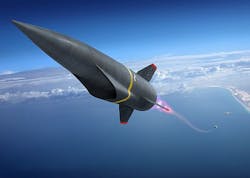Air Force asking industry for enabling technologies for future hypersonic munition
EGLIN AIR FORCE BASE, Fla., 14 May 2015. U.S. Air Force researchers are moving forward with a program to develop a hypersonic munition able to attack and destroy targets quickly over long distances, and pose lethal threats to many different targets in many different locations all at the same time.
Officials of the Air Force Research Laboratory Munitions Directorate at Eglin Air Force Base, Fla., issued a broad agency announcement (BAA-AFRL-RWK-15-0003) on Wednesday for new enabling technologies to support the High Speed Strike Weapon (HSSW) program.
The overall program includes two demonstrations for an air-breathing vehicle and a boost-glide vehicle that focus on near-term enabling technologies that require flight testing. Working on these demonstrations are engineers at the Boeing Co. and Lockheed Martin Corp.
Ultimately the program seeks to develop a hypersonic weapon able to attack any target in the world in 30 minutes or less from land- or carrier-based aircraft, submarines, or other platforms. Hypersonic technology would enable U.S. forces to avoid using ballistic missiles that could trigger massive retaliation from adversaries like Russia and China.
The part of the program announced this week centers on maturing technologies in six areas: modeling, simulation, and analysis (MS&A); ordnance; guidance navigation and control and airframe; propulsion; materials and structures and manufacturing; and conceptual design and systems integration.
The demonstration efforts will run in parallel with the Boeing and Lockheed Martin technology-maturing efforts; each will provide data and information to eliminate duplication of effort, Air Force officials say.
The solicitation announced Wednesday will be open until September 2020, and seeks white papers until then on industry ideas for the six technology-maturing areas. Air Force researchers will invite proposals based on the white papers they like best.
Each of the six technology areas has a technical adviser, and researchers recommend that companies interested first talk to the adviser their ideas before proceeding with the white paper. Over the next five years researchers may issue requests for proposals in specific topic areas.
The program's modeling, simulation, and analysis component seeks to develop models to analyze advanced high-speed weapon concepts to highlight technologies worthy of further consideration. Technical points of contact are Pamela Pitchford, whose phone number is 850-883-2505, and email address is [email protected], or James Weber, 937-255-5125, and [email protected].
Ordnance seeks to develop ordnance technologies for high-speed delivery that can withstand the effects of extreme heating and vibration during cruise, glide, and terminal phases, as well as high terminal velocities and high-Gs; and exploiting the kinetic energy of the high-speed terminal phase. Technical points of contact are Don Littrell, 850-882-6802 and [email protected].
Guidance, navigation & control, and airframe seeks to develop guidance to provide maximum range, minimum flight time, and minimum target miss distance, even in GPS-denied environments. Technical points of contact are Virginia Swindell, 850-883-2697 and [email protected].
Propulsion seeks to develop propulsion technologies to enable increased speed and effectiveness of the weapon, such as ramjet and scramjets, boosters, fuels, inlets, and nozzles. The Technical point of contact is James Weber, 937-255-5125 and [email protected].
Related: Boeing will use test results for future hypersonic applications
Material, structures, and manufacturing will develop materials for high-speed weapons that will negate or take advantage of high speed long duration flight that protect the airframe help speed the weapon to its target. The technical point of contact is Ken Davidson, 937-255-9838 and [email protected].
Conceptual design and systems integration will develop system- and subsystem-level concepts for a next-generation air-launched weapon. The technical point of contact is John Leugers, 850-883-2502 and [email protected].
Companies interested should email five-page white papers no later than 30 Sept. 2020 to the Air Force Research Lab at [email protected].
For technical questions or concerns contact the point of contact for each technical area listed above. For contracting questions contact Kendall Wagner by phone at 850-883-2681, or by email at [email protected]. For security questions contact HSSW Program Manager John Leugers by phone at 850-883-2538, or by email at [email protected].
More information is online at http://www.fbodaily.com/archive/2015/05-May/15-May-2015/FBO-03729838.htm.

